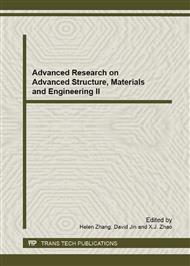p.3
p.7
p.11
p.15
p.19
p.23
p.27
p.31
p.35
Study on Solar Materials with New Solar Cell Structure Using Surface Selective Etching and Periodical Barrier Technology
Abstract:
This study presents a simple technique for improving the power conversion efficiency of a AlGaAs-GaAs based solar cell. A traditional III-V semiconductor solar cell heterojunction structure, i.e. n-GaAs/n-AlGaAs/n-GaAs/i-GaAs/p-GaAs is used. The top n-GaAs/n-AlGaAs structure is responsible for the selective etching stop layer. The selective etched surface barriers associated with polymer gratings with different aspect ratios are produced on solar cell by using the photolithography and Micro Electro Mechanical Systems (MEMS) techniques. A reflective-type diffraction optical grating is fabricated on the surface of the solar cell to redirect the incident light reflected from the solar cell back onto the solar cell surface. The experimental results show that the addition of the optical grating increases the open circuit voltage, Voc, from 4.51 V to 4.73V and improves the maximum output voltage, Vm, from 4.12V to 4.32V. From inspection of surface reflectivity , the average reflectivity is also found to be 13.7% down to 9.9 %.
Info:
Periodical:
Pages:
19-22
Citation:
Online since:
May 2013
Authors:
Price:
Сopyright:
© 2013 Trans Tech Publications Ltd. All Rights Reserved
Share:
Citation:



